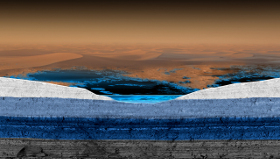Science highlights from Huygens:
#3. Methane mystery
 |
| Chemistry in Titan's atmosphere. Credit: ESA/ATG medialab |
Two of the key questions about Titan are the origin of the nitrogen and methane in its atmosphere, and the mechanisms by which methane levels are maintained. Since sunlight destroys methane irreversibly on Titan, its lifetime in the atmosphere is only tens of millions of years. Somehow the methane must be continually or periodically replenished.
The primary constituents of Titan's atmosphere were confirmed to be nitrogen and methane. In the stratosphere, levels of methane were found to be fairly low and the gas was uniformly mixed. Then, at an altitude of 40 km, in the upper troposphere, the relative amount of methane began to increase gradually until approximately 7 km, when it reached 100% relative humidity (saturation level).
For the last part of the descent, methane amounts remained relatively constant until the probe touched down on the surface. A sudden, 40% increase in the methane signal after landing, while the nitrogen count rate remained constant, suggested the presence of liquid methane on the surface. This may have been due to the spacecraft heating the surface material. This increased value for methane remained nearly constant for about one hour, with a hint of a very slight decrease in the level toward the end of this period.
 |
| Titan's subsurface reservoirs contain hydrocarbons, including methane. Credit: ESA/ATG medialab |
Measurements of the carbon isotopes in the methane provide no support for suggestions that it is generated by active micro-organisms on Titan. The methane was probably accreted by Titan during the moon's formation, and large quantities of liquid methane are now trapped in ices beneath the surface, possibly reaching the surface through some form of cryovolcanism. (Surface features associated with possible cryovolcanism have been observed by Cassini (see science highlight #5: Radioactive decay and cryovolcanism).) This activity would replace the methane that is lost as a result of photochemistry in the atmosphere.
The spectra taken on the surface also showed signatures characteristic of more complex hydrocarbons, such as ethane, cyanogen and benzene.





